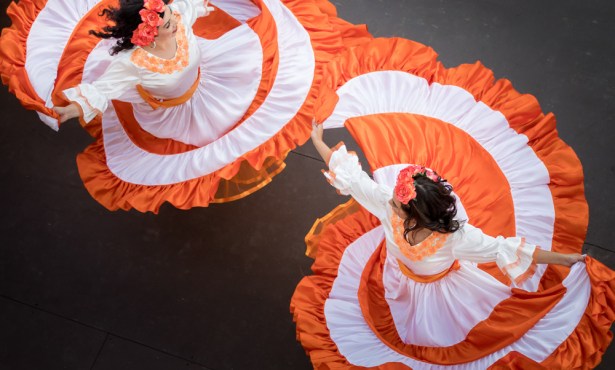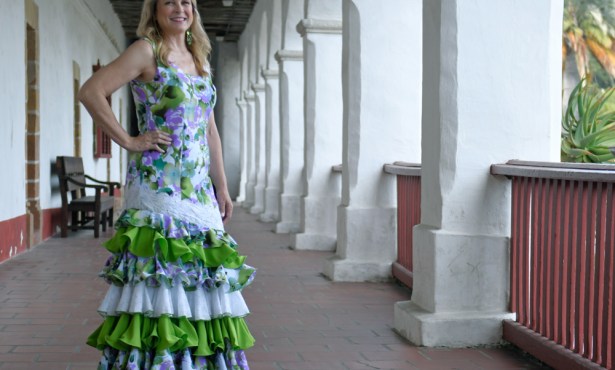Memorable Events in S.B.’s History
A Chronology

To many who sat through the interminable high school history classes learning the names of Roman emperors or what centuries denote the Middle Ages, history is nothing more than names and dates. It is to these readers, who performed the dance of joy on completing their last required history class, that we offer this history of Santa Barbara: stripped down to the bone and sinew, to names and dates.
This chronology is selective; some will be aghast at what was left out, others may be amazed at what was included, and to others it will all be new. Viva!
1542
Juan Rodriguez Cabrillo is the first European to set eyes upon the Santa Barbara area as he leads his expedition northward up the channel. Cabrillo never lands here and dies in January of the following year. His is believed to be buried on San Miguel Island.
1602
The expedition of Sebastian Vizca-no sails northward through the channel on December 4, the feast day of Saint Barbara. As is the Spanish custom, Vizca-no has the channel named in her honor.
1769
Members of the Gaspar de Portola expedition are the first Europeans to set foot in the Santa Barbara area. The expedition’s scout is Jose Francisco de Ortega, who will later serve as the first commandante of the Santa Barbara Presidio.
1782
Padre Junipero Serra blesses a cross planted at the modern-day intersection of Santa Barbara and Canon Perdido streets, marking the site of the last of the four presidios established by the Spanish government in Alta California. This is considered the founding of Santa Barbara.
1786
Father Fermin Francisco de la Lasuen, presidente of the California missions, blesses the site for the Santa Barbara Mission on Saint Barbara’s feast day, December 4.
1792
The Royal Presidio is completed. George Vancouver, the first non-Spanish European to visit Santa Barbara, stops here during his first of three voyages to California.
1795
The first public school in Santa Barbara, the second in Alta California, is founded. The first school was established a year earlier in San Jose.
1810
Revolution against Spanish rule breaks out in Mexico.
1812
One of the largest earthquakes in California history devastates Santa Barbara. Tidal wave reaches the area of present-day Anapamu Street.
1816
Ship’s carpenter Daniel Call jumps ship and becomes Santa Barbara’s first American settler.
1822
Mexico wins independence from Spain and California now comes under Mexican authority.
1824
Revolt flares among the Chumash Indians at missions La Pur-sima, Santa Ines, and Santa Barbara. Rebel forces hold out at La Pur-sima for nearly a month before surrendering. The Chumash from Mission Santa Barbara flee to the Central Valley, returning four months later.
1826
The first meeting of a town council marks the change from military to civilian government in Santa Barbara.
1846
The Mexican-American War breaks out. Commodore Robert Stockton captures Santa Barbara. Mexican forces retake the city before it finally falls to American forces under the command of John C. Fremont.
1849
The Gold Rush opens the gates of California to a flood of newcomers trying to strike it rich.
1850
California is admitted to the union as the 31st state. Santa Barbara County and the City of Santa Barbara are established. At this time, Santa Barbara County also includes Ventura County. (Population for the entire county: 1,185.)
1851
Salisbury Haley is hired by the common council of the city to survey and lay out a street grid. Mistakes in the survey will lead to years of property disputes and litigation.
1855
The Weekly Gazette becomes the city’s first newspaper.
1856
The Santa Barbara lighthouse begins operation. Julia Williams will begin 40-year career as lighthouse keeper in 1865. The (wo)manned lighthouse, destroyed in the 1925 earthquake, will be replaced by an automated light.
1860
Population is 2,351.
1862-4
Following a winter of flooding, the county is wracked by a two-year drought that virtually destroys the cattle industry, reducing the herds in Santa Barbara County from some 300,000 head to 5,000 animals.
1870
Population is 2,970.
1872
Jose Lobero opens his opera house at Anacapa and Canon Perdido streets. The completion of Stearns Wharf allows deep-draught vessels to call at Santa Barbara. Gas lighting illuminates State Street, which extends for the first time from the sea all the way to Mission Street.
1873
Santa Barbara and Ventura counties become separate entities.
1875
The first horse-drawn streetcar line begins service.
1876
The Arlington Hotel, the city’s first luxury destination resort, opens its doors on State Street between Victoria and Sola streets. Tourism will become ever more important to the city’s economy.
1878
Santa Barbara High School graduates its first senior class.
1880
Population is 3,460.
1886
The railroad reaches Santa Barbara from the south. The city celebrates the centennial of the Old Mission with a grand festival and parade. Fifteen people subscribe to the first telephone service in the city.
1887
Santa Barbara gets its first electric lights.
1891
Cottage Hospital opens. President Benjamin Harrison visits the city and is greeted with a floral parade.
1896
The completion of the first electric streetcar line will eventually spell the end of the horse-drawn cars.
1900
Population is 6,587.
1901
The “Ellwood Gap” is closed, linking Santa Barbara by rail with northern California. Stagecoach service to the city comes to an end. President William McKinley visits.
1903
The 600-room Potter Hotel opens for business at West Beach. President Theodore Roosevelt visits.
1908
St. Francis Hospital is dedicated. The Great White Fleet of the U.S. Navy pays a visit to Santa Barbara. The city responds with a festival and grand parade down what is now Cabrillo Boulevard.
1909
The Arlington Hotel is consumed by fire. A second Arlington, built in the Mission Revival architectural style, will rise in its place.
1910
Population is 11,659. The Flying A Studio builds the largest indoor movie studio in the country in the block between State and Chapala streets, about Mission Street.
1919
After eight years in construction, Mission Tunnel is completed, connecting the city to Gibraltar Reservoir. Thought to be the answer to the city’s water needs, continued population growth will raise renewed concerns about an adequate water supply within a few years.
1920
Population is 19,441.
1921
The Potter Hotel is destroyed by fire. There is talk of arson, but no definitive evidence ever comes to light.
1924
The new Lobero Theatre, designed by George Washington Smith and Lutah Riggs, opens. The city celebrates with a week-long festival honoring the Spanish roots of the town: the beginning of the Old Spanish Days Fiesta. The Granada Theatre and El Paseo also open their doors.
1925
An earthquake estimated at 6.3 on the Richter scale rocks Santa Barbara. The city will be rebuilt with an emphasis on the Spanish-Colonial style of architecture.
1929
The highlight of this year’s Fiesta is the official dedication of the new Santa Barbara County Courthouse.
1930
A major oil field is discovered in the Ellwood area. Population is 33,613.
1931
The Arlington Theatre, built upon the site of the Arlington Hotel, opens for business.
1936
The Goleta Airport opens. Construction of the Santa Barbara County Bowl, built under the auspices of the U.S. Government’s Works Progress Administration, is completed.
1938
Sansum Clinic begins operation.
1940
Population is 34,558.
1941
Santa Barbara gears up for war. Hoff Army Hospital opens. A Japanese submarine shells the Ellwood oil fields-the only attack on the continental United States during the war-but causes very little damage.
1945
Westmont College and Brooks Institute of Photography are founded.
1946
The Music Academy of the West begins operation. The Fiesta Parade is renamed El Desfile Historico.
1947
State Street gets its first traffic lights.
1948
Severe drought causes cancelation of Fiesta.
1950
Population is 44,759.
1953
Cachuma dam is completed.
1954
UCSB moves from Alameda Padre Serra to its new home, the former Marine air station in Goleta.
1958
Cachuma dam spills.
1960
El Pueblo Viejo (Old Town) ordinance is passed, protecting older buildings in the downtown area and regulating construction of new buildings. Population is 58,758.
1963
The zoo at the Child’s Estate opens.
1964
More than 80,000 acres are charred in the Coyote Canyon Fire.
1967
The Downtown Business Organization is formed to promote business. La Cumbre shopping mall opens.
1969
An oil blowout at Union Oil’s Platform A in the channel focuses the nation’s environmental concerns on Santa Barbara, and is credited with being the catalyst for the modern environmental movement.
1970
Protests at UCSB against the Vietnam War reach their climax with the burning of the Bank of America in Isla Vista. Population is 70,215.
1971
Four people die and some 15,000 acres burn in the Romero Canyon Fire.
1972
The nation’s first Egg McMuffin is served by a McDonald’s restaurant in Santa Barbara.
1973
The Harbor restaurant on Stearns Wharf burns down.
1977
The Sycamore Canyon Fire destroys more than 270 homes in Santa Barbara and Montecito.
1980
Population is 74,414.
1987
The Red Lion Resort opens for business down at the waterfront.
1990
The Painted Cave Fire destroys more than 600 structures in the most destructive fire in the city’s history. A record low temperature of 20 degrees is recorded. The Paseo Nuevo shopping mall opens downtown. Population is 85,571.



